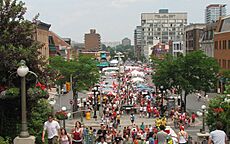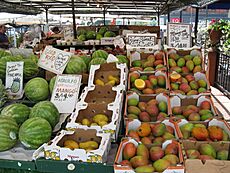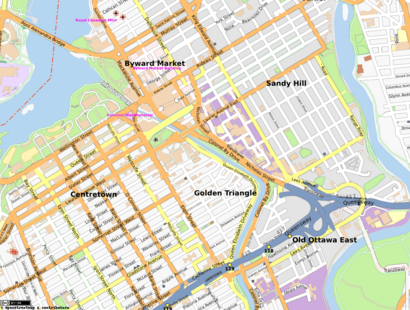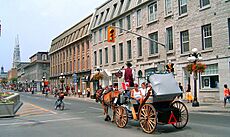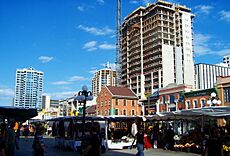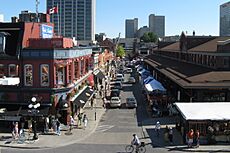ByWard Market facts for kids
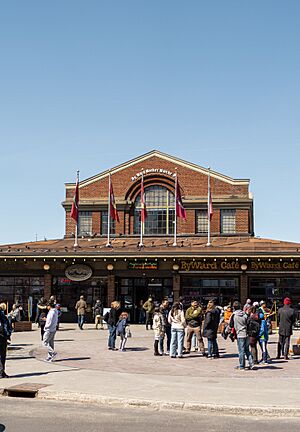
Market building
|
|
| Coordinates | 45°25′38″N 75°41′32″W / 45.4271°N 75.6923°W |
|---|---|
| Address | 55 ByWard Market Square Ottawa, Ontario K1N 9C3 |
| Goods sold | Produce, Souvenirs, Food, Jewelry |
The ByWard Market (also known as French: Marché By) is a lively area in downtown Ottawa, Ontario, Canada. It's a popular spot for shopping, eating, and having fun. You'll find it just east of Ottawa's main government and business buildings.
This special district includes market buildings and outdoor stalls. These are spread along George, York, ByWard, and William streets. The market area is named after the old "By Ward" of Ottawa. This name comes from John By, the engineer who first planned the area. It's a key part of Ottawa's historic Lower Town.
The market is managed by the ByWard Market District Authority. This group makes sure everything runs smoothly. The main market building is open all year. During warmer months, you can also find outdoor stalls selling fresh fruits, vegetables, and flowers. A popular treat sold here is the BeaverTail, a flat, fried dough pastry with different toppings.
Contents
Exploring the ByWard Market Neighbourhood
Historically, the ByWard Market was a central place for Ottawa's French and Irish communities. The large Catholic community helped build the Notre-Dame Cathedral Basilica. This is one of Ottawa's biggest and oldest Roman Catholic churches.
The ByWard Market area is always changing. It adapts to the modern feel of downtown Ottawa. Today, you'll find many restaurants and unique food shops here. This makes the neighbourhood one of the busiest spots in Ottawa, even after regular business hours.
The area around the market has the most restaurants, cafes, and nightclubs in the capital region. Beyond this main zone, you can also find many cool boutiques and eateries. You might even see buskers (street performers) entertaining crowds. The ByWard Market is known as a top spot for young adults to hang out at night.
Over the years, the city has created five open-air courtyards. These are just east of Sussex Drive. They are beautiful spaces with cobblestones, flowers, benches, and sculptures. Many of the buildings around them are historic. The United States Embassy is also located nearby.
Today, the neighbourhood is very diverse. You'll see young professionals, families, and many tourists visiting. Most people here speak English, but there's also a good number of French speakers. The market is close to the Rideau Centre shopping mall. It's also near Parliament Hill and several foreign embassies.
A Look Back: History of the ByWard Market
In 1826, Lieutenant Colonel John By came from England. He was in charge of building the Rideau Canal system. This canal was meant to connect the Ottawa River to Kingston. Because of this huge project, a small community called Bytown grew. It quickly became a busy center for trade and business.
Colonel By planned two village sites. One was on the west side of the Rideau Canal, called Upper Town. The other was to the east, called Lower Town. The land was cleared and divided into building lots. Lower Town was originally bordered by the Rideau River, Sussex, Clarence, and Rideau streets. It also had a special area for businesses. This was between George, Sussex, York, and King streets.
At first, Bytown was divided. Not just by the canal, but also by people's backgrounds. Upper Town was settled by officers and tradesmen. Most were Protestants of English or Scottish descent. Lower Town was settled by workers who came to build the canal. These were mainly Catholic Irish immigrants and French Canadians. In 1827, the two towns were connected by Sappers Bridge on Rideau Street.
The First Market Building
In 1827, Colonel By used money from property rents to build the first market. It was on George Street, with a courthouse behind it. This building was made of timber and had a veranda on each side. It was used for market activities and public meetings.
In the 1830s, Lower Town grew very fast. All kinds of stores, hotels, and industrial buildings appeared around the market. The first sawmill in Bytown was on York Street. Soon, Lower Town became the main business area.
The market on George Street became very busy. It supplied goods to lumber camps. Farmers sent their products to merchants in the Lower Town Market. A large meat industry also grew across from the market. This area was known as the "Butcher's Shambles." By 1840, a public well was opened in the market square. Lower Town was now a well-known business and living area.
In 1842, the first market building was taken down. But the market continued to operate in a less organized way. The local community needed a market to keep growing. When Bytown became a town in 1847, the new city council made an organized market a top priority.
The Second Market Building
The council decided that two markets should be built. One for Upper Town and one for Lower Town. In Lower Town, Mrs. James Inglis gave her land for the market. This was between Clarence and York Streets.
The Lower Town Market Building officially opened on November 6, 1848. This new market was made of wood. It had space for stalls on the ground floor. The upper floor was used for public meetings.
In September 1849, the market area saw the "Stony Monday Riot." This conflict was between Catholic Reformers and Protestant Tories. It started during a meeting in the Lower Town market building. A stone-throwing fight began, and later, a gun battle. One person was killed, and many were hurt.
The Lower Town market kept doing well in the 1850s. It became so crowded that the council decided to expand it. In 1853, more land was bought for expansion. A bell was also installed to help manage market hours.
The Third Market Building
On January 21, 1862, the market building was destroyed by fire. Other fires also slowed the market's growth in the 1860s and 1870s. But the market still kept going. In 1864, a new building was started. It opened in 1865. It offered better indoor spaces for sellers.
From 1840 to 1870, Ottawa's economy changed a lot. The city became more important as a trading center for farm products. All this activity went through the ByWard Market. So, the market area grew. York, ByWard, and William Streets became very busy. Many businesses were here, like bakeries, factories, and furniture makers. Other shops sold farm tools, flour, groceries, and hardware.
Many service businesses also grew. These included saddlers, tailors, and metal workers. Butchers, fishmongers, and fruit sellers lined the streets. The Lapointe Fish Market, started in 1867, is still in the market today!
The market building itself was divided into sections. There were spots for farmers, gardeners, florists, and livestock dealers. These sections had stalls that sellers rented each year. A Market Inspector was in charge of the area.
The Fourth Market Building
Because of constant crowding and mess, the council wanted to expand the market again in 1871. On April 14, 1876, a new building designed by James Mather opened. It was a beautiful two-story building with towers. The dirty By Wash at the south end was covered and turned into a sewer.
The ByWard Market continued to thrive into the 1900s. French-Canadian and Jewish merchants became very important in the market. The market also had to change with new technologies like refrigeration and cars. Rideau Street became a major business area, and department stores became popular.
The Fifth Market Building (Today)
In 1926, James Mather's market building was completely destroyed by fire. It was replaced by the building you see today between George and York Streets. Another stone market building was taken down in 1949. The empty space became a parking lot. In 1975, a parking garage was built during big renovations. The side facing York Street became commercial space. It now has restaurants, a produce store, and Aubrey's butcher shop, which has been there since 1908.
Today, the market area still feels like its past. Since the 1840s, the ByWard Market has been a main center for business, fun, and relaxation. It has changed from a small outpost to the heart of Canada's National Capital Region. Many of the old businesses have been replaced by boutiques and restaurants. But people from Ottawa and tourists still come here. They buy fresh produce and enjoy the colorful sellers and street entertainment.
In October 2000, a company called CHUM Limited opened a new studio complex in the ByWard Market. This building at 87 George Street was called the CHUM MarketMediaMall. Several TV and radio stations moved into this new building. Later, these stations became part of CTV and then Bell Media.


